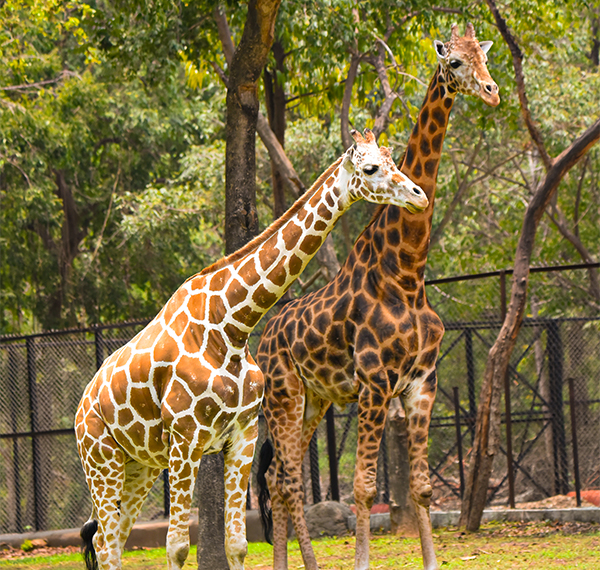Total Weight
Height
Diet
Lifespan
Total Weight
Height
Diet
Lifespan
The giraffe is the tallest living terrestrial animal, with an average height of around
5 meters, and is the largest ruminant. Giraffes primarily live in the savannahs of the Sub-Saharan
region of Africa.Sanjay Gandhi Biological Park, Patna, has a breeding captive population of giraffes. In 2006,
Patna Zoo received 1 male (Vikas) and 2 females (Shanti and Shrishti) from San Diego Zoo, USA,
under an animal exchange program.In 2011, one female giraffe was born from Vikas and Shanti and was later transferred to
Nandankanan Zoo in 2012. Unfortunately, the male giraffe (Vikas) passed away on 23.10.2012.
In 2014, Sanjay Gandhi Biological Park received a male giraffe, Bhima, from Mysore Zoo under another animal exchange program.
Currently, Sanjay Gandhi Biological Park houses 5 giraffes: 2 males (Aman and Bhima) and 3 females (Shanti, Hima, and Himani).


The giraffe enclosure at Patna Zoo provides a spacious and natural habitat for these
majestic animals. It features large open areas with tall trees and vegetation, mimicking their
natural savannah habitat.
The enclosure includes elevated platforms to accommodate the giraffes' height and allow visitors to
observe them at eye level. There are also feeding stations where the giraffes receive a balanced diet
of leaves, hay, and specially formulated pellets.
The enclosure is designed to promote the well-being and natural behavior of the giraffes while ensuring
a safe and enriching experience for both the animals and visitors.
The giraffe, with its long neck and gentle nature, gracefully roams at Patna Zoo, fascinating visitors with its elegance.
Explore Patna Zoo’s giraffe habitat and witness these gentle giants gracefully roam, showcasing their unique beauty and fascinating behavior.
| Attribute | Details |
|---|---|
| Weight | Male: 800-1,200 kg, Female: 550-1,180 kg |
| Height | Male: 16-18 ft, Female: 14-16 ft |
| Diet | Leaves, shoots, fruits, and flowers, primarily from acacia trees |
| Lifespan | 20-25 years in the wild, up to 30 years in captivity |
| Conservation Status | Vulnerable |
| Population in the Wild | Approximately 117,000 giraffes left in Africa |
| Social Structure | Live in loose herds, typically 10-20 members |
| Unique Behavior | Use long tongues (up to 18 inches) to grasp leaves and avoid thorns |
| Hunting Pattern | Herbivores — constantly browsing for food throughout the day |
| Mane Equivalent | Short, upright mane running along the neck |
| Closest Relatives | Okapi — both belong to the Giraffidae family |
Giraffes are herbivores, meaning they eat plants, and their diet mainly consists of leaves, flowers, fruits, and twigs from trees and shrubs. Their favorite food comes from acacia trees,
which are abundant in their natural habitats across the African savannah. Giraffes have long necks that allow them to
reach high branches, giving them access to food that other animals cannot reach. Their tongues, which can be up to 18
inches long, are tough and prehensile, helping them grasp leaves and even navigate around sharp thorns.
In addition to
acacia, giraffes also eat leaves from mimosa and wild apricot trees, as well as various fruits and flowers.
They can consume up to 75 pounds of vegetation in a single day. Despite their size, giraffes only need to drink water
every few days because they get much of their moisture from the plants they eat.
Open Now
All visits to Patna Zoo help fund our work both at the zoo and worldwide.
Giraffes, the tallest land animals, have a truly fascinating anatomy designed for life in the African savannah. Their long necks, which can reach up to 6 feet in length,
allow them to browse leaves high up in trees where few other animals can reach. Despite their long necks, giraffes have only seven neck bones — the same number
as humans!
Giraffes also have long, sturdy legs, with front legs slightly longer than their back legs, helping them run up to 50 km/h.
Their spotted coat works as natural camouflage, blending into the dappled light of trees. Another unique feature is their 18-inch-long tongue, dark in color to protect against sunburn.
Visit Patna Zoo to discover these gentle giants and learn more about their amazing adaptations!
